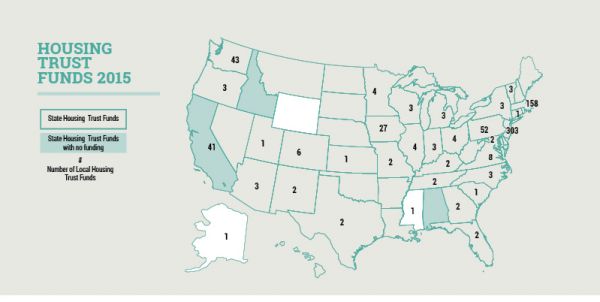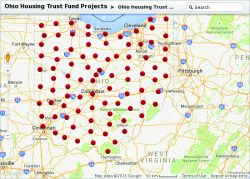HAC News: September 13, 2018
HAC News Formats. pdf
September 13, 2018
Vol. 47, No. 19
Congress still working on appropriations for FY19 and on Farm Bill • Rural homeownership funds on track to be fully used this fiscal year • Puerto Rican families’ hotel aid ends September 13 • U.S. poverty falls for third year in a row • USDA proposes making two-tier “income banding” permanent for homebuyers • FY19 Fair Market Rents posted •Grants offered for repairs to water and waste systems impacted by Hurricanes Harvey, Irma and Maria • RUS to stop publishing funding notices in Federal Register • HUD to expedite waivers for public housing agencies in major disaster areas • USDA extends deadline for ERS and NIFA headquarters • Common platform suggested for some USDA loan guarantees • Report shows first homes financed by national Housing Trust Fund • States implementing Opportunity Zones, report says
HAC News Formats. pdf
September 13, 2018
Vol. 47, No. 19
REGISTRATION IS NOW OPEN FOR THE 2018 HAC RURAL HOUSING CONFERENCE!
The conference will be held December 4-7 at the Capital Hilton in Washington, DC.
Congress still working on appropriations for FY19 and on Farm Bill.
Congress has divided appropriations bills for FY19, which begins October 1, into several “minibuses.” The USDA and Transportation-HUD measures are combined with the Interior Department’s bill, and the programs’ funding levels are still under discussion in conference committee. At press time it is not clear which bills may pass before the end of the month and which parts of the government may operate under continuing resolutions or, possibly, be shut down. If the Democrats win a majority in either the House or the Senate in the November elections, they are likely to make changes in FY19 appropriations. Congress is also working to finish negotiations on the Farm Bill because the current version expires September 30.
Rural homeownership funds on track to be fully used this fiscal year.
As of August 31, USDA has made 6,209 mortgages from its Section 502 direct program totaling about $945.6 billion, higher than the $911.7 billion obligated by the same date last year. It seems likely to use all available funds for this program by the end of FY18 on September 30, as it did last year. The proportion of Section 502 direct funds loaned to very low-income borrowers is currently 33.2%, below its 37.6% at this time last year and 38.1% at the end of last year.
Puerto Rican families’ hotel aid ends September 13.
A federal judge has allowed FEMA to end its Temporary Shelter Assistance program for Hurricane Maria evacuees who have been staying in hotels. The judge encouraged FEMA and others to work together to help find temporary housing. Agencies in New York, Florida, and Massachusetts are assisting those who need aid.
U.S. poverty falls for third year in a row.
Annual Census Bureau data on income, poverty, and health insurance show an official U.S. poverty rate of 12.3% in 2017, down from 12.7% in 2016. In nonmetro areas, poverty dropped from 15.8% in 2016 to 14.8% in 2017. National poverty rates for African-Americans and Hispanics remained higher than those of other races/ethnicities, at 21.2% and 18.3%, respectively.
USDA proposes making two-tier “income banding” permanent for homebuyers.
A proposed rule would make several changes to the Section 502 direct and guaranteed loans, including adopting a pilot that broadens eligibility and has been tested in select states since FY16. To qualify for a mortgage, a family with between one and four people would need to have an income below HUD’s four-person limit, and a family with between five and eight would need to fall below the eight-person amount. Comments are due October 30. For more information, contact Shannon Chase, RD, 515-305-0399.
FY19 Fair Market Rents posted.
HUD’s Fair Market Rents for FY19 will be effective on October 1 unless HUD receives requests by that date for reevaluation of specific area FMRs. For more information, contact local HUD program staff.
Grants offered for repairs to water and waste systems impacted by Hurricanes Harvey, Irma and Maria.
The Rural Utilities Service has over $163 million to make grants for repairs to drinking water systems and sewer and solid waste disposal systems impacted by Hurricanes Harvey, Irma, and Maria in Florida, Georgia, South Carolina, Texas and the territories of Puerto Rico and Virgin Islands. Applications will be accepted until funds are exhausted. Contact an RD state office.
RUS to stop publishing funding notices in Federal Register.
Effective immediately, USDA’s Rural Utilities Service will post Notices of Funds Availability only on grants.gov and on its own site. For more information, contact Michele Brooks, RD, 202-690-1078.
HUD to expedite waivers for public housing agencies in major disaster areas.
For the rest of calendar year 2018, HUD will use an expedited process to review requests from PHAs located in major disaster areas for waivers from HUD regulatory and/or administrative requirements. For more information, contact Shelia Bethea, HUD, 202-402-8120.
USDA extends deadline for ERS and NIFA headquarters.
October 15 is now the deadline for submissions of interest for new Economic Research Service and National Institute of Food and Agriculture headquarters. (See HAC News, 8/15/18.) For more information, contact Donald K. Bice, USDA, 202-720-3291.
Common platform suggested for some USDA loan guarantees.
RD proposes to create a “common platform” for making, servicing, and monitoring four (non-housing) guaranteed loan programs: the Community Program Guaranteed loan program, the Water and Waste Disposal Guaranteed loan program, the Business and Industry Guaranteed loan program, and the Rural Energy for America Program guaranteed loans. Comments are due October 22, 2018. Listening sessions are scheduled for several dates, ending September 20. To request government-to-government consultation, a tribe may contact RD’s Native American Coordinator, 720-544-2911. For other information, contact Michele Brooks, USDA, 202-690-1078.
Report shows first homes financed by national Housing Trust Fund.
Issued by the National Low Income Housing Coalition, Getting Started: First Homes Being Built with 2016 National Housing Trust Fund Awards summarizes information from 42 states that are using HTF money to build or preserve rental homes for extremely low-income households. States are prioritizing projects to serve people experiencing homelessness, people with disabilities, elderly individuals, veterans, and other special needs populations.
States implementing Opportunity Zones, report says.
CDFA Opportunity Zones Report: State of the States, an update from the Council of Development Finance Agencies, includes descriptions of several states’ outreach and planning strategies as they move forward with Opportunity Zones, a new financing vehicle created in the December tax law.
NEW! HAC offers Section 502 packaging training course in Nebraska, Oct. 30-Nov. 1.
This three-day advanced course trains experienced participants to assist potential borrowers and work with RD staff, other nonprofits, and regional intermediaries to deliver successful Section 502 loan packages. The registration fee is $500. The training will be held October 30-November 1 in Lincoln, NE. For more information, contact HAC staff, 404-892-4824.
Need capital for your affordable housing project?
HAC’s loan funds provide low interest rate loans to support single- and multifamily affordable housing projects for low-income rural residents throughout the U.S. and territories. Capital is available for all types of affordable and mixed-income housing projects, including preservation, farmworker, senior, and veteran housing. HAC loan funds can be used for pre-development, site acquisition, site development, and construction/rehabilitation. Contact HAC’s loan fund staff at hacloanfund@ruralhome.org, 202-842-8600.
Please note: HAC is not able to offer loans to individuals or families. Borrowers must be nonprofit or for-profit organizations or government entities (including tribes).




